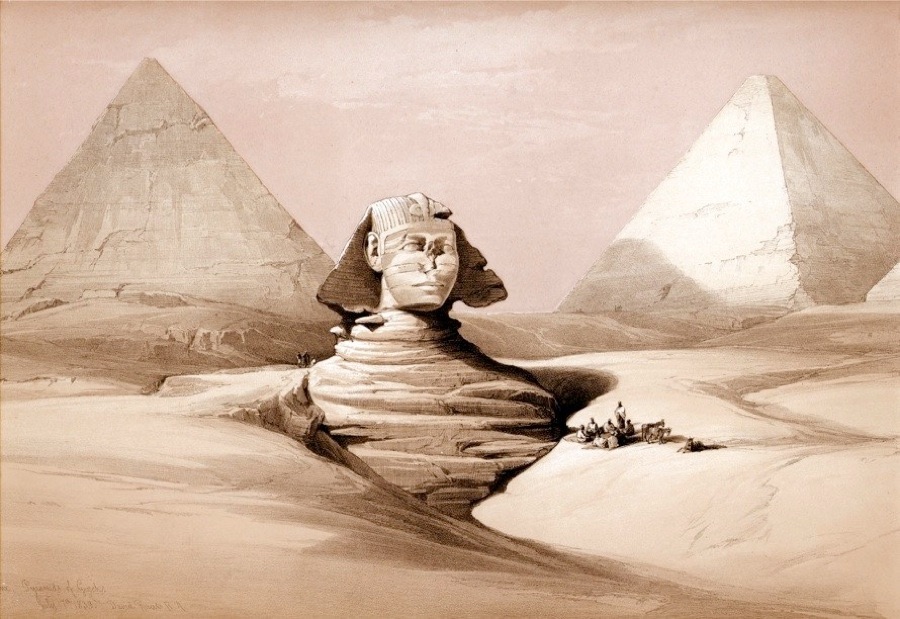HEAD OF THE GREAT SPHINX, PYRAMIDS OF GEEZEH.
NO monument in existence strikes the observer with a greater impression of vastness than the Sphinx near the Pyramids of Geezeh: when brought by the judgement of an observer into comparison with the human head, which it represents (for this part alone of the figure appears above the level of the rock, out of which it rises), it overwhelms by its immensity all other colossal imitations. If the head of a man be taken at a length of ten inches from the top to the chin, it is here sculptured of the enormous length of twenty-eight feet six inches, which presents a bulk nearly 40,000 times greater than its original.
This marvellous figure is cut out of the solid rock from a mass that projects above the general level of the bed of a rather soft greyish-white limestone, upon which the Pyramids are built, which extends up the valley of the Nile at a general elevation of about one hundred and fifty feet above the level of the river and in some places one hundred and twenty feet above the sandy plain around it.
It is remarkable that Herodotus, who was furnished us with details of the Pyramids, has been altogether silent on the great Sphinx: that it was in existence when he was in Egypt there cannot be a doubt. On its breast a granite tablet was found, bearing the cartouche of Thothmes IV., in the date of whose reign, 1561 B.C. chronologists agree; but they differ widely upon that of Suphis, or Cheops, whose cartouche, found within the Great Pyramid, confirms the statement of Herodotus that he was its founder. Wathen, by close and powerful argument, places the reign of Cheops in 941B.C., 620 years later than the age of the Sphinx; but Wilkinson, who is profound in the subject, carries it back to 2123 B.C., thus making the Pyramids 562 years older than the Sphinx. As, however, this stupendous figure existed 1100 years before the visit of the Greek historian to Egypt, 470 B.C., the omission of all mention of the Sphinx by him, may, perhaps, be accounted for by the probability that the text of Herodotus is imperfect. It is known that Aristotle refers to passages in this author which are not to be found in the text which has descended to us.
About twenty years ago M. Caviglia succeeded in accomplishing what the French attempted but did not complete, the laying open of the whole front of the Sphinx. When the sand, after immense labour, was removed, this stupendous figure was disclosed in all its height from the top of the head to the floor of the Temple between its paws, above one hundred feet: its total length is one hundred and forty-six feet; the breadth across the shoulders thirty-four feet; height to the top from the sand in front forty-four feet six inches; height from the back of the shoulders to the top of the head twenty-seven feet. The whole is cut from the solid rock, except the fore legs, or paws, which are of masonry, and project fifty feet from the breast of the figure; between them lies a small Temple.
By these excavations an approach from the rocky plain above was laid open before the figure, nearly three hundred feet in length, first by a long and gradual incline, and then by two descending flights of steps to the platform of the Temple, where altars and many other antique fragments were found that are now deposited in the British Museum.
The head of the Sphinx is so much broken and injured, that the different opinions upon its expression and character have had free scope: Langles, in his “Notes on Norden,” says it was thus mutilated by a fanatic Sheikh of the Sofi sect in 1379. From what remains, there appears to have been the quiet repose and dignity of expression, which generally characterised the colossal sculpture of that remote but, in this art, highly advanced period.
The Pyramids in this view are, that of Cheops, or the Great Pyramid, seen on the right of the observer, and, on the left, that of Cephren, which is called the Second Pyramid.
Mr. Perring’s Notes. Appendix to Colonel Vyse’s Pyramids of Gizeh. Wikinson Egypt and Thebes.


